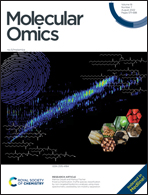Metabolomic analysis of honey bee (Apis mellifera L.) response to glyphosate exposure†
Abstract
Glyphosate is among the world's most commonly used herbicides in agriculture and weed control. The use of this agrochemical has unintended consequences on non-target organisms, such as honey bees (Apis mellifera L.), the Earth's most prominent insect pollinator. However, detailed understanding of the biological effects in bees in response to sub-lethal glyphosate exposure is still limited. In this study, 1H NMR-based metabolomics was performed to investigate whether oral exposure to an environmentally realistic concentration (7.12 mg L−1) of glyphosate affects the regulation of honey bee metabolites in 2, 5, and 10 days. On Day 2 of glyphosate exposure, the honey bees showed significant downregulation of several essential amino acids, including leucine, lysine, valine, and isoleucine. This phenomenon indicates that glyphosate causes an obvious metabolic perturbation when the honey bees are subjected to the initial caging process. The mid-term (Day 5) results showed negligible metabolite-level perturbation, which indicated the low glyphosate impact on active honeybees. However, the long-term (Day 10) data showed evident separation between the control and experimental groups in the principal component analysis (PCA). This separation is the result of the combinatorial changes of essential amino acids such as threonine, histidine, and methionine, while the non-essential amino acids glutamine and proline as well as the carbohydrate sucrose were all downregulated. In summary, our study demonstrates that although no significant behavioral differences were observed in honey bees under sub-lethal doses of glyphosate, metabolomic level perturbation can be observed under short-term exposure when met with other environmental stressors or long-term exposure.



 Please wait while we load your content...
Please wait while we load your content...